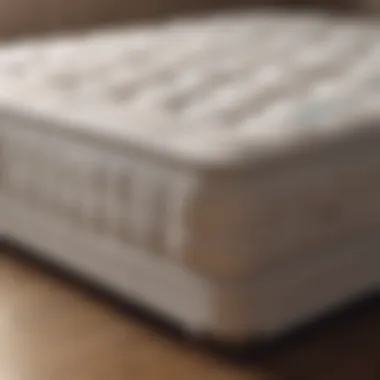Can a Mattress Last 20 Years? Insights on Durability


Intro
The discussion around mattress longevity is essential for those prioritizing their health. Many wonder if a mattress can indeed last for two decades without significant loss of comfort or support. Factors such as materials, manufacturing standards, and maintenance practices play a vital role in this durability. This article will provide detailed insight into these factors and guide readers on optimal practices to ensure their mattress can endure the test of time.
Key Benefits
Understanding how a quality mattress influences sleep can change lives. Sleep is crucial for both physical and mental health. A good mattress supports the body properly, ensuring restful sleep.
Physical Health Benefits
- Spinal Alignment: A well-constructed mattress provides necessary support for the spine. This alignment helps prevent back pain, a significant issue for many individuals.
- Pressure Relief: Quality mattresses distribute weight evenly. This characteristic helps alleviate pressure points, which can contribute to less tossing and turning at night, resulting in better sleep.
- Allergen Resistance: Some materials, like memory foam and latex, resist dust mites and other allergens, promoting a healthier sleep environment.
- Temperature Regulation: Certain mattresses incorporate cooling technologies. These features can enhance comfort during sleep, aiding in physiological health.
Mental Well-being Enhancements
- Reduced Stress: Good sleep quality is often linked to lower stress levels. With the right mattress, individuals can experience improved sleep quality, leading to better overall mood and resilience against anxiety.
- Enhanced Cognitive Function: Quality sleep aids in memory and focus. A proper mattress contributes to restful nights, improving daytime productivity.
"Sleep is not just a time to recharge; it's essential for both mental clarity and emotional stability."
- Better Mood Regulation: Improved sleep helps individuals regulate their moods. An optimal mattress can play a crucial role in achieving this restful backdrop.
Practical Tips
Evaluating Durability
When shopping for a mattress, consider the materials and construction. Look for high-density foams and durable coils. Research specific brands like Tempur-Pedic, Saatva, or Purple.
Maintenance Practices
- Regular Rotation: Rotate your mattress every few months to ensure even wear.
- Use a Protector: Mattress protectors not only keep the mattress clean but also extend its life.
- Avoid Excessive Weight: Do not place heavy objects on your mattress for extended periods. This practice can cause sagging.
Signs of Wearing Out
- Noticing lumps or sagging in the mattress.
- Increased discomfort or pain upon waking.
- Allergies flaring up more than usual.
By understanding these elements, consumers and health-conscious individuals can make informed decisions. Their choices about mattresses have long-term implications for their sleep quality and overall well-being.
Understanding Mattress Lifespan
Understanding the lifespan of a mattress is crucial for anyone concerned about sleep quality and overall well-being. A mattress represents a significant investment and influences health, comfort, and daily energy levels. Knowing how long a mattress can last empowers consumers to make informed decisions about their sleep environment and its maintenance.
Mattresses do not just serve the purpose of providing a place to sleep; they are essential components of one’s health routines. Comfortable sleep can improve mood and cognitive function, while an unsuitable mattress can lead to discomfort, sleep disturbances, and long-term health issues.
Being aware of a mattress's lifespan also helps in planning budget allocations. A mattress that lasts longer minimizes the frequency of replacements, leading to cost savings in the long run. Therefore, understanding how to assess mattress longevity and taking the right care steps can contribute to optimal usage and satisfaction.
Defining Lifespan in Sleep Products
Lifespan in sleep products like mattresses refers to the period during which the mattress maintains its structural integrity and comfort. This includes considerations like support and comfort level alongside the absence of visible wear or damage. A mattress should ultimately provide restful sleep and sustain body posture, particularly the spine.
Some factors used to evaluate mattress lifespan include the type of materials used, the quality of craftsmanship, and how well the mattress has been maintained over time. Moreover, distinctions between types of sleep styles and body weights can lead to varying experiences regarding the effective lifespan of a mattress.
General Expectations for Mattress Longevity
The general expectation for mattress longevity varies depending on the type of mattress.
- Innerspring mattresses typically last about 7 to 10 years. Their internal coils can sag or break over time, leading to diminished support and comfort.
- Memory foam mattresses may last around 10 to 15 years. High-density foam may retain its shape better but can still develop body impressions.
- Latex mattresses often last the longest, with life expectancy from 15 to 20 years. The natural elasticity of latex can retain shape well even with regular use.
- Hybrid mattresses, comprising elements from both innerspring and foam mattresses, may offer varying life spans averaging 10 to 15 years depending on their materials.
Consumer expectations should align with these general guidelines. The durability often reflects quality. Higher-quality materials generally deliver longer-lasting products.
"Understanding the expected lifespan of a mattress helps consumers make choices that align with their needs, comfort, and budget."
Considering the types and qualities available in the market, understanding mattress longevity contributes significantly to a better-informed and healthier sleeping routine.
Types of Mattresses
Understanding the different types of mattresses is crucial when considering longevity and comfort for sleep. Each type comes with its own unique features, materials, and qualities that contribute to its lifespan. The choice of mattress can greatly influence not just the duration it can last but also the quality of sleep. Seeking to address an array of preferences and needs, mattresses vary significantly in terms of support, comfort, and durability.


Innerspring Mattresses
Innerspring mattresses are among the most traditional options available. They rely on a system of coils to provide support and typically have a foam or fiber padding on top for comfort. This type has been popular for decades due to its availability and relatively lower cost.
One clear advantage is breathability, as the springs promote airflow. However, they may wear out faster than more modern materials, especially if the coil construction is not high quality. Issues like sagging and noise can become apparent over time.
Common characteristics include:
- Varying coil counts, which can impact firmness.
- Availability in firm, plush, or pillow-top options.
- Typically have shorter lifespans, generally around 6 to 8 years.
Memory Foam Mattresses
Memory foam mattresses are designed to contour to the body, providing tailored support and comfort. This material reacts to body heat and weight, creating a personalized sleep surface. They tend to isolate motion well, making them ideal for couples who do not want to be disturbed by each other's movements during the night.
This variety offers durability, often lasting between 10 to 15 years when properly maintained. However, they may retain heat more than other options, which can be a consideration for some sleepers.
Key attributes include:
- Excellent body contouring and pressure relief.
- High-density foams generally hold up better over time.
- Importance of density and foam type for longevity.
Latex Mattresses
Latex mattresses, made from natural or synthetic latex, provide a resilient support system. The material is known for its durability and ability to bounce back quickly, resisting sagging over time. Natural latex particularly appeals to those seeking eco-friendly options, as it is derived from rubber trees.
These mattresses often last longer than their innerspring or memory foam counterparts, frequently exceeding 15 years of effective use. The added resilience can offer support that lasts through years of nightly use.
Distinct advantages include:
- Naturally hypoallergenic and resistant to dust mites.
- Good airflow and temperature regulation.
- Availability in different firmness levels to cater to various sleepers.
Hybrid Mattresses
Hybrid mattresses combine the best features of innerspring and foam or latex, aiming to deliver a balanced sleep experience. Typically, they consist of a coil support base, topped with layers of foam or latex for added comfort. This unique structure seeks to provide support while also accounting for body contouring needs.
Durability can vary based on the materials used. A well-constructed hybrid mattress can last anywhere from 10 to 15 years. These mattresses hanlde a variety of sleeping positions, contributing to their popularity.
Core features include:
- Enhanced support and pressure relief.
- Diverse construction options allow for customization.
- Often retain the benefits of both support and comfort.
Factors Influencing Mattress Longevity
Understanding the factors that influence mattress longevity is crucial for anyone considering whether their mattress can last two decades. Mattress durability is not simply a matter of time but is influenced by a complex interplay of various elements. Knowing these factors helps consumers make informed purchasing decisions and maintain their sleep products effectively.
Material Quality
The quality of materials used in mattress construction plays a critical role in determining how long it will last. High-quality materials are more resilient and less susceptible to wear and tear. For instance, memory foam, which is known for its comfort and support, can degrade more quickly if it is of low density. Innerspring mattresses may suffer from sagging due to poor steel quality in their coils.
Consider the following types of materials:
- Latex: Generally lasts longer due to its natural elasticity and durability.
- Memory Foam: Ensure it has a high density to prevent quick degradation.
- Innerspring Coils: Look for high-quality steel and more coils for increased support and longevity.
Investing in a mattress with superior materials can reduce replacement frequency. A better-quality mattress often translates to a better sleep experience and overall health benefits.
Usage Patterns
How a mattress is used significantly affects its lifespan. Regular usage habits, such as how many people sleep on it, the weight they carry, and even the sleep positions, can contribute to its wear.
- Frequency of Use: Mattresses that are used every night will wear out faster than those used occasionally.
- Weight Distribution: Heavier individuals can cause more prominent indentations or sagging over time.
- Sleep Positions: Side sleepers may compress certain areas more, leading to uneven wear.
Additionally, if pets frequently share the bed, that can also add to the wear. It is essential for consumers to assess their habits and consider how they can adjust them to prolong the life of the mattress.
Environmental Conditions
The environment where the mattress is kept also has a significant impact on its longevity. Various factors such as temperature, humidity, and exposure to direct sunlight can affect the materials in a mattress.
- Humidity Levels: High humidity can lead to mold and mildew, particularly in memory foam and latex mattresses.
- Temperature: Excessive heat can degrade materials, causing faster wear. Ideally, mattresses should be kept in a climate-controlled room.
- Sunlight Exposure: Prolonged exposure to sunlight can cause fading of fabrics and weaken some materials.


Creating an appropriate environment not only helps maintain the quality of the mattress but also contributes to better sleep quality. Use of mattress covers can further mitigate some adverse effects of the environment.
"Understanding the interplay of material quality, usage patterns, and environmental conditions is essential for protecting your investment in a mattress."
Overall, a thorough comprehension of the factors influencing mattress longevity allows individuals to make better choices regarding their sleep products. This awareness contributes to healthier sleep habits and ultimately, an improved quality of life.
Maintenance and Care
Maintenance and care play a crucial role in determining the longevity and performance of a mattress. Without proper attention, even the highest quality mattress may falter over time. Regular upkeep ensures that the mattress retains its support, comfort, and hygiene, ultimately contributing to better sleep quality. By understanding and implementing various care techniques, users can maximize the lifespan of their sleep surface.
Regular Cleaning Practices
Keeping a mattress clean is essential for both hygiene and durability. Dust mites, allergens, and other contaminants can accumulate over time, affecting sleep quality and overall health. Here are some practical cleaning practices:
- Vacuuming: Use a vacuum with an upholstery attachment to remove dust and debris from the mattress surface. This should be done at least once a month.
- Spot Cleaning: In case of spills or stains, it is best to tackle them immediately. Using a mild soap solution on a clean cloth can help remove unwanted marks. Avoid soaking the mattress to prevent mold and mildew growth.
- Deodorizing: Sprinkling baking soda on the mattress and letting it sit for several hours can effectively neutralize odors. Vacuum it off afterward for freshness.
Keeping your mattress clean not only enhances its lifespan but also promotes better sleep health.
Using a Mattress Protector
A mattress protector is one of the simplest yet most effective means of safeguarding a mattress. These specialized covers can prevent spills, sweat, and allergens from penetrating the mattress. Here are key benefits of using one:
- Protection from Stains: A protector creates a barrier against liquids and stains, preserving the mattress's appearance and preventing deterioration.
- Allergen Defense: Many protectors are designed to be hypoallergenic, repelling dust mites and other allergens that can trigger health issues.
- Ease of Cleaning: Mattress protectors can usually be removed and washed easily, ensuring a hygienic sleeping environment.
Rotation and Flipping
Many mattresses benefit from being rotated or flipped periodically. This practice helps distribute weight evenly across the surface, minimizing sagging and wear in specific areas. Recommended practices include:
- Rotation: Rotating the mattress every three to six months can help maintain its shape and support. This is particularly important for non-flippable mattresses.
- Flipping: For flippable designs, consider flipping it every six months. This will evenly distribute use and reduce the risk of developing uncomfortable indentations.
- Check Manufacturer Guidelines: Always refer to the manufacturer's instructions, as some mattresses are not meant to be flipped.
By integrating these maintenance practices, a mattress can achieve its fullest potential in terms of durability and user satisfaction.
Signs Your Mattress Needs Replacement
Understanding when to replace a mattress is crucial for maintaining proper sleep quality and overall health. Over time, mattresses experience wear and tear, and these changes may not always be obvious. Knowing the signs your mattress needs replacement empowers consumers to make timely decisions, ensuring their sleep environment is conducive to restful nights. If you notice any of the following indicators, it might be time for an upgrade.
Physical Signs of Wear and Tear
The physical condition of a mattress often speaks volumes about its remaining lifespan. Common indicators of wear include:
- Sagging: If the surface no longer feels even and has noticeable dips, support is compromised.
- Visible Damage: Rips, tears, or lumps are clear signs of degradation. These problems can lead to discomfort and a decrease in support.
- Edge Compression: If the edges of the mattress feel softer than the center, it may signal weakening materials.
Even if the mattress appears visually acceptable, these indicators can affect comfort levels significantly. Regularly inspecting the mattress can help identify these issues early.
Discomfort and Sleep Quality Issues
If consistent discomfort arises during sleep, this might suggest a problem with your mattress. Signs include:
- Waking Up with Pain: If you encounter persistent pain or stiffness upon waking, the mattress may no longer provide adequate support for your body.
- Restlessness: Frequent tossing and turning throughout the night can signal that the mattress no longer meets your comfort needs.
- Feeling Trapped: Memory foam mattresses should conform, but after a time, they can become overly compressive, which may lead to feelings of being stuck.
The importance of a good night’s sleep cannot be understated. Lack of quality sleep can lead to numerous health issues. Therefore, taking action at the first sign of discomfort is important.
Allergic Reactions and Hygiene Concerns
Another significant aspect to consider is the impact of a mattress on your allergies and overall hygiene. Over time, mattresses can accumulate dust mites, mold, and other allergens, leading to:
- Increased Allergies: Persistent sneezing, nasal congestion, or skin irritations may indicate a buildup of allergens in the mattress.
- Odors: A noticeable smell emanating from the mattress can suggest trapped moisture or mold growth, compromising its hygiene.
- Stains: Visible stains from spills or bodily fluids not only look unsightly but also harbor bacteria that can worsen allergic conditions.
Maintaining a clean sleep environment is essential for physical well-being. If issues arise in this area, replacing the mattress may prove necessary for better health and comfort.
Material Innovations in Mattress Industry
Material innovations in the mattress industry play a crucial role in determining the longevity and comfort of sleep products. With advancements in technology, manufacturers are now able to create mattresses that not only enhance sleep quality but also address health and environmental concerns. This section explores the significant developments in materials used in mattresses, the benefits they offer, as well as considerations for consumers looking to invest in a quality sleep product.
Emerging Technologies


In recent years, a wave of emerging technologies has reshaped the landscape of mattress production. Innovations include new types of memory foam, cooling gel layers, and responsive materials that adjust to the sleeper's body shape and weight. These technological advancements lead to several benefits:
- Enhanced Comfort: New materials like gel-infused memory foam provide better support and temperature regulation, improving overall sleep comfort.
- Durability: Mattresses made from advanced materials tend to have a longer lifespan, resisting sagging and wear over time.
- Customization: Many brands now offer smart mattresses that can be adjusted electronically based on individual preferences, further enhancing user satisfaction.
These technologies have made it possible for consumers to find options that cater directly to their unique sleep needs. However, it is important for buyers to research these features thoroughly. Understanding which materials align with their sleep habits will help them make informed choices.
Sustainability Trends
Sustainability has become a key focus in the mattress industry, influencing both production and material choices. As eco-consciousness grows among consumers, manufacturers are increasingly adopting sustainable practices. Key sustainability trends include:
- Natural Materials: Products made from organic cotton, natural latex, and wool are appealing to many buyers. These materials not only minimize environmental impact but also offer improved breathability and safety.
- Recyclable Products: Brands are developing mattresses that can be recycled at the end of their life, reducing waste in landfills.
- Eco-Friendly Manufacturing: Many companies are integrating sustainable practices in their production processes to lessen their carbon footprint, including using renewable energy sources and reducing chemical usage in materials.
"Investing in a sustainable mattress not only benefits your sleep but also the planet."
These trends reflect a growing awareness of environmental issues. Consumers who prioritize sustainability can enjoy peace of mind, knowing their purchase contributes to a healthier planet. As consumers become more educated, demand for these types of innovations is expected to rise, pushing the industry towards even higher standards of responsibility.
Consumer Behavior and Preferences
Understanding consumer behavior is crucial when discussing mattress longevity. Preferences in mattresses influence purchasing decisions significantly. This section examines the factors that shape these choices, emphasizing how comfort and price influence consumers.
Importance of Comfort
Comfort is paramount for anyone looking to buy a mattress. It significantly impacts sleep quality, directly relating to one's health and well-being. A comfortable mattress supports the body properly, reduces pressure points, and aids in spinal alignment. Research indicates that individuals who prioritize comfort tend to report better sleep quality.
When consumers evaluate comfort, they often rely on personal experience and how it feels during testing in stores. Factors like firmness, materials used, and surface texture play essential roles in this evaluation. Different sleep positions, such as back, side, or stomach sleeping, demand different levels of support and comfort from a mattress. This diversity in preferences makes customization vital. Mattresses that adapt to individual body shapes, such as memory foam or hybrid options, often receive higher marks for comfort.
Value vs Price Considerations
The balance between value and price is a critical aspect of mattress purchases. Consumers often face the dilemma of choosing between cheaper options and more premium products. It is essential to distinguish between the two to ensure a wise investment. A low-priced mattress may seem appealing initially, but it often lacks durability and support.
Higher-priced mattresses, while initially daunting, often come with better materials and craftsmanship. They may last longer and provide superior comfort, thus offering real value in the long term. Matresses like Tempur-Pedic or Saatva, known for their quality, show how investing more can lead to greater satisfaction over time.
Considerations include:
- Material quality
- Warranty and service options
- Customer reviews and experiences
Ultimately, being informed can lead to better decisions. Consumers need to view mattress purchases as long-term investments for their health and comfort, rather than just immediate expenses.
The choice of a mattress is not just about comfort. It reflects an awareness of one's health and investment in quality sleep.
Making an Informed Choice
Making an informed choice when selecting a mattress is crucial for long-term comfort and health. This topic connects deeply to the overall durability and wellness benefits of a mattress. Understanding the variables involved can assist in ensuring that your investment provides adequate support and sleep quality over the years.
Choosing the right mattress involves assessing personal preferences and needs. The type of mattress can greatly influence your sleep quality and comfort. Therefore, it's essential to consider how various materials, firmness levels, and construction techniques suit your specific body type and sleeping position.
Additionally, informed choices can lead to better health outcomes. For instance, a well-suited mattress can help in reducing discomfort, alleviating joint pain, and improving overall sleep hygiene. Furthermore, understanding the longevity of mattress types aids in evaluating the long-term value of your purchase.
Benefits of Making an Informed Choice
- Enhanced sleep quality: A mattress that meets your needs improves overall restfulness.
- Value retention: Selecting a durable product ensures you get value for your expenditure.
- Health considerations: Alleviating discomfort can prevent long-term health issues related to sleep.
- Awareness of trends: Staying informed about innovations can lead to smarter purchases.
For all these reasons, the focus should be on gathering adequate information before making a final decision. Do not rush the process; thoughtful consideration yields tangible benefits in the long run.
Evaluating Options Before Purchase
When evaluating options, it is essential to do thorough research. Begin by identifying what features matter most to you—be it firmness, material types, or support systems. Many customers find benefit in testing mattresses in stores, but with the rise of online shopping, comprehensive reviews become invaluable.
It is prudent to consider factors such as:
- Trial periods: Some brands offer extended trial periods, allowing you to test comfort at home.
- Warranty and durability: Ensure the warranty length reflects the product's expected lifespan.
- Comparison of materials: Different materials like memory foam, latex, and innerspring all have distinctive pros and cons.
A chance to physically try the mattress can enhance your decision-making but isn’t always feasible. Thus, online resources and customer feedback can fill that gap effectively. Analyze descriptions thoroughly and take note of repeated customer concerns or praises.
Return Policies and Trials
Understanding return policies is key when making your final decision. A flexible return policy gives customers peace of mind. It is common for leading brands to provide trial periods, some exceeding 100 days.
Key points about return policies include:
- Exchange options: Some brands allow exchanges if the original option does not meet needs.
- Free return shipping: This can alleviate concerns over unintended purchases.
- Conditions of return: Always review the requirements, such as mattress cleanliness or damage terms.
In addition, don’t underestimate the value of a trial period. Having time to adjust to a new mattress can reveal its true comfort level. If a mattress feels off after several weeks, knowing you can return it without hassle is a crucial feeling of security for any buyer. It protects both the investment and well-being.















